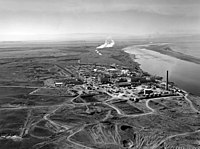
Photo from wikipedia
An essential part of a protection strategy for radiological emergencies is the development of national dose criteria and of operational intervention levels (OILs) to decide about protective measures for all… Click to show full abstract
An essential part of a protection strategy for radiological emergencies is the development of national dose criteria and of operational intervention levels (OILs) to decide about protective measures for all ten scenarios Germany is preparing. For the process of planning and implementing such protection strategies as required by the German Radiation Protection Law the Federal Ministry BMU has commissioned the German Radiation Protection Commission (SSK) to recommend dose criteria and OILs for emergency response measures. OILs link a chosen dose criterion for a protective action with a suitable measurement of the contamination situation such as ambient dose rate (μSv h−1), contamination level on surfaces (Bq cm−2) or activity content (Bq g−1, Bq cm−3). This link should adequately model the exposure of persons during a defined exposure period (e.g. seven days, one year) caused by the measured contamination. Dose calculations to quantify OILs should apply assumptions and parameter values that are in tendency realistic and not unduly conservative. OILs have been developed for the following emergency response actions based on radiation measurements: Sheltering on the basis of dose rate (μSv h−1) and contamination level(Bq cm−2). Evacuation on the basis of dose rate (μSv h−1) and contamination level(Bq cm−2). Establishing a radiological hazard area to implement access andcontamination control on the basis of dose rate (μSv h−1) and contaminationlevel (Bq cm−2). Contamination control and possibly decontamination of persons and objects(items, goods, vehicles, etc) based on contamination level (Bq cm−2). A set of precautionary early actions: warning the population not toconsume freshly contaminated food and agricultural measures to reducefood contamination based on dose rate (μSv h−1). Application of maximum permitted levels of radioactive contamination offood and feed (Bq kg−1) according to Euratom Regulation. Sheltering on the basis of dose rate (μSv h−1) and contamination level(Bq cm−2). Evacuation on the basis of dose rate (μSv h−1) and contamination level(Bq cm−2). Establishing a radiological hazard area to implement access andcontamination control on the basis of dose rate (μSv h−1) and contaminationlevel (Bq cm−2). Contamination control and possibly decontamination of persons and objects(items, goods, vehicles, etc) based on contamination level (Bq cm−2). A set of precautionary early actions: warning the population not toconsume freshly contaminated food and agricultural measures to reducefood contamination based on dose rate (μSv h−1). Application of maximum permitted levels of radioactive contamination offood and feed (Bq kg−1) according to Euratom Regulation.
Journal Title: Journal of Radiological Protection
Year Published: 2021
Link to full text (if available)
Share on Social Media: Sign Up to like & get
recommendations!